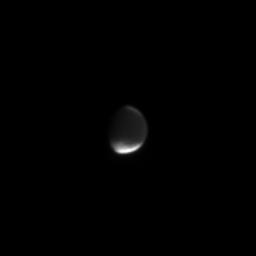Iapetus’ Dark Side
Caption:
This image shows the dark, leading hemisphere of the mysterious moon Iapetus. The dark area is the Cassini region, named for Giovanni Cassini, who discovered the moon in 1672. The diameter of Iapetus is 1,436 kilometers (892 miles).
Cassini noted that he was able to see the moon on one side of its orbit around Saturn, but not on the other side. From this, he correctly deduced that one hemisphere must be dark while the other is much brighter.
The image was taken in visible light with the Cassini spacecraft narrow angle camera on Sept. 24, 2004, at a distance of 7.4 million kilometers (4.6 million miles) from Iapetus and at a Sun-Iapetus-spacecraft, or phase, angle of 51 degrees. The image scale is 45 kilometers (28 miles) per pixel. The image has been magnified by a factor of four to aid visibility.
Background Info:
The Cassini-Huygens mission is a cooperative project of NASA, the European Space Agency and the Italian Space Agency. The Jet Propulsion Laboratory, a division of the California Institute of Technology in Pasadena, manages the Cassini-Huygens mission for NASA's Science Mission Directorate, Washington, D.C. The Cassini orbiter and its two onboard cameras were designed, developed and assembled at JPL. The imaging team is based at the Space Science Institute, Boulder, Colo.
For more information, about the Cassini-Huygens mission visit,
http://saturn.jpl.nasa.gov
and the Cassini imaging team home page,
http://ciclops.org
.
Cataloging Keywords:
| Name |
Value |
Additional Values |
| Target |
Iapetus |
Saturn |
| System |
Saturn |
|
| Target Type |
Satellite |
Planet |
| Mission |
Cassini-Huygens |
|
| Instrument Host |
Cassini Orbiter |
|
| Host Type |
Orbiter |
|
| Instrument |
Imaging Science Subsystem (ISS) |
|
| Detector |
Narrow Angle Camera |
|
| Extra Keywords |
Grayscale, Visual |
| Acquisition Date |
|
| Release Date |
2004-11-16 |
| Date in Caption |
|
|
| Image Credit |
NASA/JPL/Space Science Institute |
| Source |
photojournal.jpl.nasa.gov/catalog/PIA06521 |
| Identifier |
PIA06521 |

 Planetary Data System
Planetary Data System
